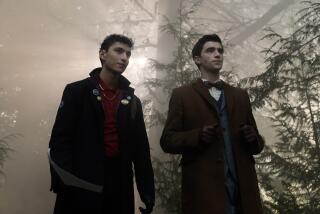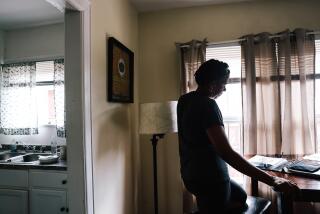Group of Sleuths Reopens Unsolved Mysteries, but All Aren’t Elementary
PHILADELPHIA — In the wood-paneled Downtown Club, the Vidocq Society is having lunch. The setting is elegant, the topic anything but.
This group of present and former law enforcement sleuths is trying to find a way to identify a dead boy found 41 years ago in a box.
A police officer and a local newspaper reporter pause between bites of chicken and steamed vegetables to lay out what’s known.
When the body was found off a rural road, investigators back in 1957 noted some strange details. The boy’s hair had been sloppily trimmed, his fingernails clipped. His arms were folded over his chest. A flannel blanket covered his nude body. A new cap lay nearby.
No one had ever identified the little boy. But if Bill Fleisher, the group’s commissioner, has his way, the Vidocq Society will.
“This case,” the former agent of the FBI and U.S. Customs Service declares after lunch, “is solvable.”
Twice a month, Vidocq (pronounced VEE-duck) members meet to brainstorm about unsolved crimes.
The group is not a collection of whodunit enthusiasts butting into ancient police files. The 150-plus sleuths have contacts that range from the local district attorney’s office to Scotland Yard.
Since its founding by Fleisher and others in 1990, Vidocq has consulted on a few hundred cases. It has become actively involved in a few dozen and reached convictions in two.
In a 1991 Little Rock, Ark., case, Vidocq’s work helped acquit a restaurant worker accused of beating his boss to death with what appeared to be a golf club.
“The goal starting out was for people of common interests to have some strenuous intellectual exercise,” said Fleisher. “We changed the goal to be a pro bono, nonprofit organization to help those who aren’t here to speak for themselves.”
The organization started over lunch.
Richard Walter, a prison psychologist, came into town for a convention. His friend, skull reconstructionist Frank Bender, wanted him to meet Fleisher.
Bender and Walter talked about John List, a New Jersey accountant who murdered his mother, wife and three children in 1971, then disappeared. In 1989, Bender sculpted a bust showing how he might look: fatter and balding with thick-rimmed glasses.
Eleven days after it appeared on television, List was found.
They talked about Hans Vorhauer and Robert Nauss, former biker gang members who escaped prison inside an armoire they had built in a prison workshop and sold to conspirators outside. Bender correctly modeled both, right down to Vorhauer’s bleached blond hair.
Both were arrested.
At that first meeting, the sleuths talked until dark then decided to do it again. With more people.
So was the Vidocq Society born. They named it after Eugene Francois Vidocq, a criminal turned detective in 18th century France who is credited with introducing forensics to police work.
Forensics can mean many things. Consider how Vidocq helped solve the disappearance of Scott Dunn in Lubbock, Texas, in 1991.
His apartment showed the signs of a butchering. A new patch of carpet covered a bloodstained floor. Someone had tried to clean spattered blood off the walls. But police didn’t have a body, and in time the case went cold.
Jim Dunn, Scott’s father, found Fleisher and then met with Walter.
The psychologist heard tapes of conversations between Dunn and his son’s girlfriend, Leisha Hamilton, during which she waffled between expressing concern for Scott and asking for his Camaro. Walter quickly made up his mind.
“I said to him, ‘Aren’t you tired of playing the grieving father?’ He said, ‘I thought that’s what I was supposed to be.’ I said, ‘You’re supposed to be mad. Let’s go get [her].’ ”
Walter refocused the investigation and pressed the case with local authorities.
He even got around the problem of the missing body by sending blood samples and crime-scene photos to colleagues at Scotland Yard. They concluded that the crime scene was “inconsistent with life,” and that helped prosecutors win an indictment.
Last year, Hamilton was convicted and sentenced to 20 years.
The boy-in-the-box case is more complicated. One theory was that the boy’s death had been accidental, and his family was burying him when they were frightened away.
Last year, detective Thomas Augustine called a couple who ran a foster home near where the body was found. The man told Augustine that his second wife had had a son who died as a child, in the 1950s.
Augustine’s heart leaped. But that child’s name turned up in the morgue’s records, a final false lead that sent the detective to Vidocq.
“This is going to be a wild one,” Bender said. “I’m going to take the death mask of the boy. I’m going to study it, study it, study it. And then I’m going to try to sculpt what the parents would look like.”
Another Vidocq member, retired detective Sam Weinstein, has spent weeks mining file boxes. He has already developed leads.
One led authorities to an elementary school, three miles from where the corpse was found. Police searched yearbooks and other materials. That probe continues.
A second lead involves a Colorado woman who, implicated in one child’s death, told authorities she had killed a son and left him in Philadelphia.
“Nobody can bring him back to life,” Weinstein said, explaining his fervor for this case. “But he deserves a name on that headstone.”
More to Read
Sign up for Essential California
The most important California stories and recommendations in your inbox every morning.
You may occasionally receive promotional content from the Los Angeles Times.










